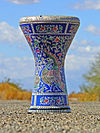- Rebab
-
This article is about the bowed instrument. For the Central Asian plucked instrument known as the "Kabuli rebab", see Rubab. For the rebab used by Sikh musicians, known as the "Seni rebab", see Seni rebab.


Rebabs
Mevlâna mausoleum, Konya, TurkeyThe rebab (Arabic الربابة or ربابة - "a bowed (instrument)"),[1] also rebap, rabab, rebeb, rababah, or al-rababa) is a type of string instrument so named no later than the 8th century and spread via Islamic trading routes[citation needed] over much of North Africa, the Middle East, parts of Europe, and the Far East. The bowed variety often has a spike at the bottom to rest on the ground, and is thus called a spike fiddle in certain areas, but there exist plucked versions like the kabuli rebab (sometimes referred to as the robab or rubab). Furthermore, besides the spike fiddle variant, there also exists a variant with a pear-shaped body, quite similar to the Byzantine lyra and the Cretan lyra. This latter variant travelled to western Europe in the 11th century,[2] and became the rebec.
This article will only concentrate on the spike-fiddle rebab, which usually consists of a small, usually rounded body, the front of which is covered in a membrane such as parchment or sheepskin and has a long neck attached. There is a long thin neck with a pegbox at the end and there are one, two or three strings. There is no fingerboard. The instrument is held upright, either resting on the lap or on the floor. The bow is usually more curved than that of the violin.
The rebab, though valued for its voice-like tone, has a very limited range (little over an octave), and was gradually replaced throughout much of the Arab world by the violin and kemenche. It is related to the Iraqi instrument the Joza, which has four strings.
Contents
Construction
The rebab is used in a wide variety of musical ensembles and genres, corresponding with its wide distribution, and is built and played somewhat differently in different areas. In Southeast Asia, the rebab is a large instrument with a range similar to the viola da gamba, whereas versions of the instrument further west tend to be smaller and higher-pitched. The body varies from being ornately carved, as in Java, to simpler models such as the 2-string Egyptian "fiddle of the Nile" may have a body made of half a coconut shell. The more sophisticated versions have a metal soundbox and the front may be half-covered with beaten copper, and half with cowskin.
Arabia, Persia and the Ottomans
The rebab was heavily used, and continues to be used, in Persian traditional music. There is also a bowed instrument in Persian music named Kamanche which has similar shape and structure. The Rebab is also played in other countries such as India, most likely tracing its origin to Greater Iran because of its use in the Sassanid court.
Asian heartland
The spike fiddle variants are very commonly used by many East and Central Asian ethnic groups and their diaspora around the world, such as the Huqin variety used by most ethnic groups of China, the morin khuur of Mongolia, the Byzaanchy of Tuva, the Kokyu of Japan, Haegeum of Korea, kyl kiak of Kyrgyzstan, Saw sam sai of Thailand and many others. These are generally used in playing traditional folk tunes, but have also become popular in arrangements of contemporary music, including such genres as classical, jazz, and rock.[4]
Malayan Archipelago
In the Indonesian gamelan the rebab is an essential elaborating instrument, ornamenting the basic melody. It does not have to conform exactly to the scale of the other gamelan instruments and can be played in relatively free time, finishing its phrases after the beat of the gong ageng (the big gong that "rules" the ensemble). The rebab also frequently plays the buka when it is part of the ensemble.[5]
In the eastern Malaysian states of Kelantan and Terengganu, the Rebab is used in a healing ritual called "Main Puteri". The musician healer is sometimes taken to hospitals in cases where doctors are unable to heal ailing patients.
See also
- Rubab (instrument)
- Rebec
- Gadulka
- Gusle
- Gudok
- Kamancheh
- Kemenche
- The lyra of Crete
- Kobyz
- Lira, the medieval bowed instrument of the Byzantine Empire
- Lijerica
Notes
- ^ http://www.si.umich.edu/chico/instrument/pages/rebab_gnrl.html
- ^ http://www.britannica.com/EBchecked/topic/487848/rabab
- ^ http://chinesefinearts.org/resources/information-about-chinese-instruments/
- ^ http://www.philmultic.com/home/instruments/erhu.html
- ^ Neil Sorrell. A Guide to the Gamelan. London: Faber and Faber, 1990. Pp. 97-98.
External links
- Turkish Rebab Master Ibrahim Metin Ugur
- Nay-Nava the encyclopedia of persian music instruments
- Rebab
- The Rebab
- Arabic rababa photo
- http://nuke.liuteriaetnica.it/Default.aspx?tabid=91
- FERNWOOD An American music group that uses a Rebab.
- Matthaios Tsahouridis
 Chisholm, Hugh, ed (1911). "Rebab". Encyclopædia Britannica (11th ed.). Cambridge University Press.
Chisholm, Hugh, ed (1911). "Rebab". Encyclopædia Britannica (11th ed.). Cambridge University Press.
References
- Margaret J. Kartomi: On Concepts and Classifications of Musical Instruments. Chicago Studies in Ethnomusicology, University of Chicago Press, 1990
Instruments and vocals used in Javanese gamelan
Colotomic instruments:
Balungan instruments:
Panerusan instruments:
Unpitched instruments:
Vocals and clapping:Kempyang and ketuk | Kempul | Kenong | Gong
Saron panerus | Saron barung | Demung | Slenthem | Slentho
Bonang | Gendér | Gambang | Siter | Celempung | Suling | Rebab
Kendang | Bedug | Kecer | Kemanak | Kepyak
Gerong | Sindhen | Alok | Senggakan | KeplokTraditional Arabic musical instruments Plucked lutes Zithers Bowed lutes Kamanjah • RababaLyres Flutes Reed instruments Drums Other percussion Categories:- Arabic musical instruments
- Bowed instruments
- Gamelan
- Indonesian musical instruments
- Lebanese musical instruments
- Pakistani musical instruments
- String instruments
- Sundanese culture
- Music of West Java
Wikimedia Foundation. 2010.




